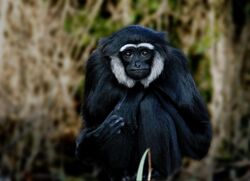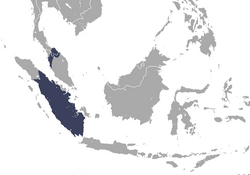Biology:Agile gibbon
| Agile gibbon[1] | |
|---|---|

| |
| A male agile gibbon | |
| Scientific classification | |
| Domain: | Eukaryota |
| Kingdom: | Animalia |
| Phylum: | Chordata |
| Class: | Mammalia |
| Order: | Primates |
| Suborder: | Haplorhini |
| Infraorder: | Simiiformes |
| Family: | Hylobatidae |
| Genus: | Hylobates |
| Species: | H. agilis
|
| Binomial name | |
| Hylobates agilis F. Cuvier, 1821
| |

| |
| Agile gibbon range | |
| Synonyms | |
| |
The agile gibbon (Hylobates agilis), also known as the black-handed gibbon, is an Old World primate in the gibbon family. It is found in Indonesia on the island of Sumatra, Malaysia, and southern Thailand. The species is listed as endangered on the IUCN Red List due to habitat destruction and the pet trade.
Taxonomy
The species is generally thought not to have subspecies, but some experts recognise a mountain form and a lowland form.[2]
- Mountain agile gibbon, Hylobates agilis agilis
- Lowland agile gibbon, Hylobates agilis unko
Description
The agile gibbon has fur varying in color from black to red-brown. The brow is white, and the male can be recognized by his white or light-grey cheeks. Additionally, the male is slightly larger than the female. The agile gibbon weighs from 4 to 6 kg (8.8 to 13.2 lb) with an average of 5 kg (11 lb), though in captivity it can reach 8 kg (18 lb).[4][5] It has a head and body length of 44–63.5 cm (17.3–25.0 in).[5] Like all gibbons, it is tailless.
Behaviour
With its long arms they swing on branches, brachiating at a fast pace. Like all gibbons, it lives in monogamous pairs in a strictly enforced territory, which is defended with vigorous visual displays and songs.[4] The diet of the agile gibbon is generally frugivorous but have also been observed eating leaves, flowers, and insects.[4]
Females give birth to a single offspring after seven months' gestation. The young gibbon is weaned at barely 2 years of age. When fully mature, at about 8 years, it leaves its family group in order to look for a mate.[4]
Distribution and habitat
The agile gibbon is found on Sumatra southeast of Lake Toba and the Singkil River, in a small area on the Malay Peninsula, and south Thailand near the Malaysian border.[2] It predominantly lives arboreally in rain forests and rarely comes to the ground.
References
- ↑ Groves, C.P. (2005). "Species Hylobates agilis". in Wilson, D.E.; Reeder, D.M.. Mammal Species of the World: A Taxonomic and Geographic Reference (3rd ed.). Baltimore: Johns Hopkins University Press. p. 179. ISBN 0-801-88221-4. OCLC 62265494. http://www.departments.bucknell.edu/biology/resources/msw3/browse.asp?id=12100758.
- ↑ Jump up to: 2.0 2.1 2.2 Geissmann, T.; Nijman, V.; Boonratana, R.; Brockelman, W.; Roos, C.; Nowak, M.G. (2020). "Hylobates agilis". IUCN Red List of Threatened Species 2020: e.T10543A17967655. doi:10.2305/IUCN.UK.2020-2.RLTS.T10543A17967655.en. https://www.iucnredlist.org/species/10543/17967655. Retrieved 19 November 2021.
- ↑ "Appendices | CITES". https://cites.org/eng/app/appendices.php.
- ↑ Jump up to: 4.0 4.1 4.2 4.3 Kuester, J. (2000). "Hylobates agilis". Animal Diversity Web. http://animaldiversity.ummz.umich.edu/site/accounts/information/Hylobates_agilis.html. Retrieved 6 January 2012.
- ↑ Jump up to: 5.0 5.1 "Fact sheet: agile gibbon". EAZA Ape Campaign. 2010. Archived from the original on 3 December 2013. https://web.archive.org/web/20131203024210/http://www.apecampaign.org/wp-content/uploads/2010/06/gibbon-agilis-fact-sheet.pdf. Retrieved 6 January 2012.
External links
- Gibbon Conservation Center
- Hylobates agilis at The Primata
Wikidata ☰ Q838962 entry
 |



